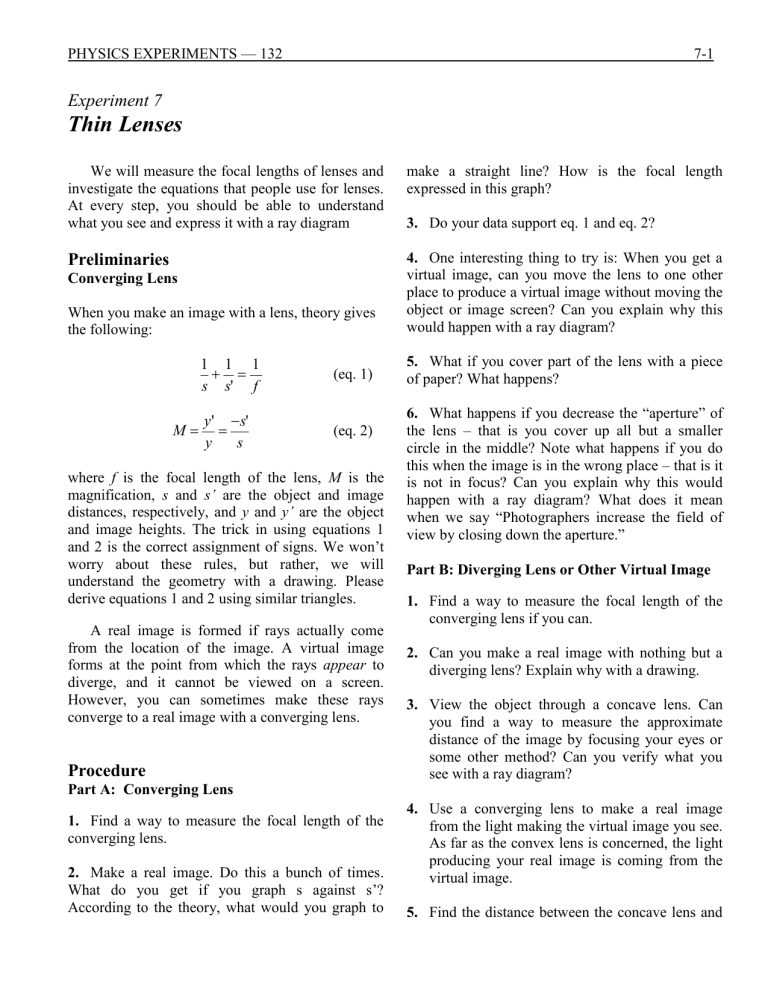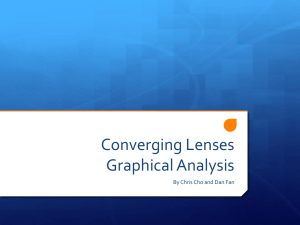Week 7 Lab (lens) PVS S2015

PHYSICS EXPERIMENTS — 132 7-1
Experiment 7
Thin Lenses
We will measure the focal lengths of lenses and investigate the equations that people use for lenses.
At every step, you should be able to understand what you see and express it with a ray diagram
Preliminaries
Converging Lens
When you make an image with a lens, theory gives the following:
1 s
+
1 s '
=
1 f
(eq. 1)
M
= y y
'
= s s '
(eq. 2) where f is the focal length of the lens, M is the magnification, s and s’ are the object and image distances, respectively, and y and y’ are the object and image heights. The trick in using equations 1 and 2 is the correct assignment of signs. We won’t worry about these rules, but rather, we will understand the geometry with a drawing. Please derive equations 1 and 2 using similar triangles.
A real image is formed if rays actually come from the location of the image. A virtual image forms at the point from which the rays appear to diverge, and it cannot be viewed on a screen.
However, you can sometimes make these rays converge to a real image with a converging lens.
Procedure
Part A: Converging Lens
1.
Find a way to measure the focal length of the converging lens.
2.
Make a real image. Do this a bunch of times.
What do you get if you graph s against s’?
According to the theory, what would you graph to make a straight line? How is the focal length expressed in this graph?
3.
Do your data support eq. 1 and eq. 2?
4.
One interesting thing to try is: When you get a virtual image, can you move the lens to one other place to produce a virtual image without moving the object or image screen? Can you explain why this would happen with a ray diagram?
5.
What if you cover part of the lens with a piece of paper? What happens?
6.
What happens if you decrease the “aperture” of the lens – that is you cover up all but a smaller circle in the middle? Note what happens if you do this when the image is in the wrong place – that is it is not in focus? Can you explain why this would happen with a ray diagram? What does it mean when we say “Photographers increase the field of view by closing down the aperture.”
Part B: Diverging Lens or Other Virtual Image
1.
Find a way to measure the focal length of the converging lens if you can.
2.
Can you make a real image with nothing but a diverging lens? Explain why with a drawing.
3.
View the object through a concave lens. Can you find a way to measure the approximate distance of the image by focusing your eyes or some other method? Can you verify what you see with a ray diagram?
4.
Use a converging lens to make a real image from the light making the virtual image you see.
As far as the convex lens is concerned, the light producing your real image is coming from the virtual image.
5.
Find the distance between the concave lens and
PHYSICS EXPERIMENTS — 132 7-2 the virtual image. Do this experimentally and data from your graph in part A.
6.
From the distances above, calculate the focal length of the diverging lens. Does this agree with the measurement you made in #1?
7.
You can repeat this experiment for a virtual image produced by a convex lens too! …if you like.
Questions
(Answer clearly and completely).
1.
Do your data support equations 1 and 2?
2. Did your two methods finding the focal lengths of the converging lens agree?
3.
Did your two methods finding the focal lengths of the diverging lens agree?
4.
What happens to the image if half of the converging lens is covered?
PVS 5/15






